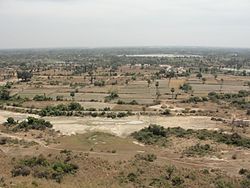Sittannavasal
| Sittannavasal | ||
|---|---|---|
|
|
||
| State : |
|
|
| State : | Tamil Nadu | |
| District : | Pudukkottai | |
| Sub-district : | Iluppur | |
| Location : | 10 ° 28 ' N , 78 ° 44' E | |
| Height : | 125 m | |
| Area : | 6.36 km² | |
| Residents : | 1,935 (2011) | |
| Population density : | 304 people / km² | |
| Sittannavasal - View over the landscape | ||
Sittannavasal or Sithanavasal is a village with about 2,000 inhabitants in the southern Indian state of Tamil Nadu ; it is known for a nearby 7th century Jain cave.
location
Sittannavasal is about 18 km (driving distance) northwest of the district capital Pudukkottai at an altitude of about 125 m above sea level. d. M. The almost tropical climate is usually humid; Rain falls mainly in the monsoon months from July to December.
population
The inhabitants of the rural place are almost exclusively Hindus . The female share of the population only slightly exceeds the male population.
economy
For centuries, the residents of the village have primarily made their living from agriculture. Small traders, craftsmen and day laborers have settled in the village. Tourism hardly plays a role.
history
Prehistoric monuments (burial mounds, stone circles, etc.) have been discovered in the vicinity of the village. In the early Middle Ages, the area belonged to the Pallava Empire, which was gradually taken over by the regaining strength of the Chola Empire in the 9th century . However, there were persistent conflicts with the early medieval pandyas , who are considered to be the supporters of Jainism and donors of the temple; the paintings are sometimes dated a century later.
Attractions
- At the foot of about 1 km south of the village located about 70 m high rock massif are the remains of "megalithic" barrows ( tumuli ) in which also stone boxes or urns ( cists ) etc. were discovered.
- On the back of the rock at a site called Ezhadippattam there are some ancient inscriptions and several figures of Jain ascetics carved into the rock.
- The most important sight, however, is the Jain cave temple ( Arivar Koil ), which was carved into a rock cliff with great effort. The temple consists of a modern entrance hall, which protects an inscription from the 8th century, as well as a portico-like , transversely rectangular vestibule ( mandapa ) with two Jaina figures on the side (one of them can be identified as Parshvanata because of the snake hood ) and a slightly elevated cella ( garbhagriha ), in the back wall of which three tirthankaras can be seen in the lotus position and with their hands clasped in their lap ( dhyanamudra ). A circular structure ( dharmachakra ) is carved out of the ceiling . There are numerous older inscriptions and newer graffiti in the floor of the temple . To some extent, ceiling and column paintings can still be seen, showing various figures, including animals, in a lotus pond; one figure wears a lotus flower and is thus perhaps identified as a Bodhisattva Padmapani - the representations are interpreted as Samavasarana , the "paradise" of the Jainas. Reconstructions of the paintings can be seen in the Thirumalai Nayakkar Mahal Museum in Madurai .
Web links
- Sittannavasal, sights - photos, floor plan + information (English)
- Sittannavasal, Jain Cave Temple - Photo + Info ( ASI , English)
- Sittanavasal, Jain Cave (Wikipedia, English)







